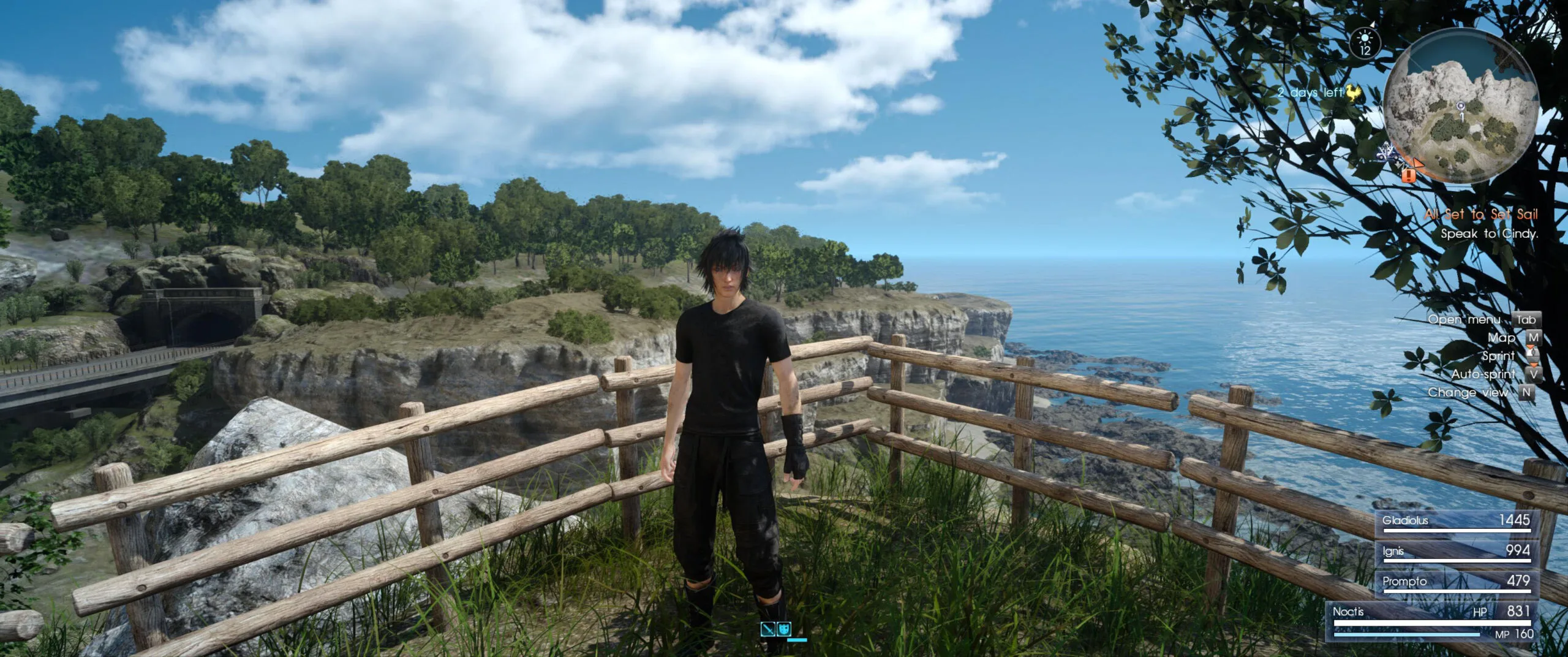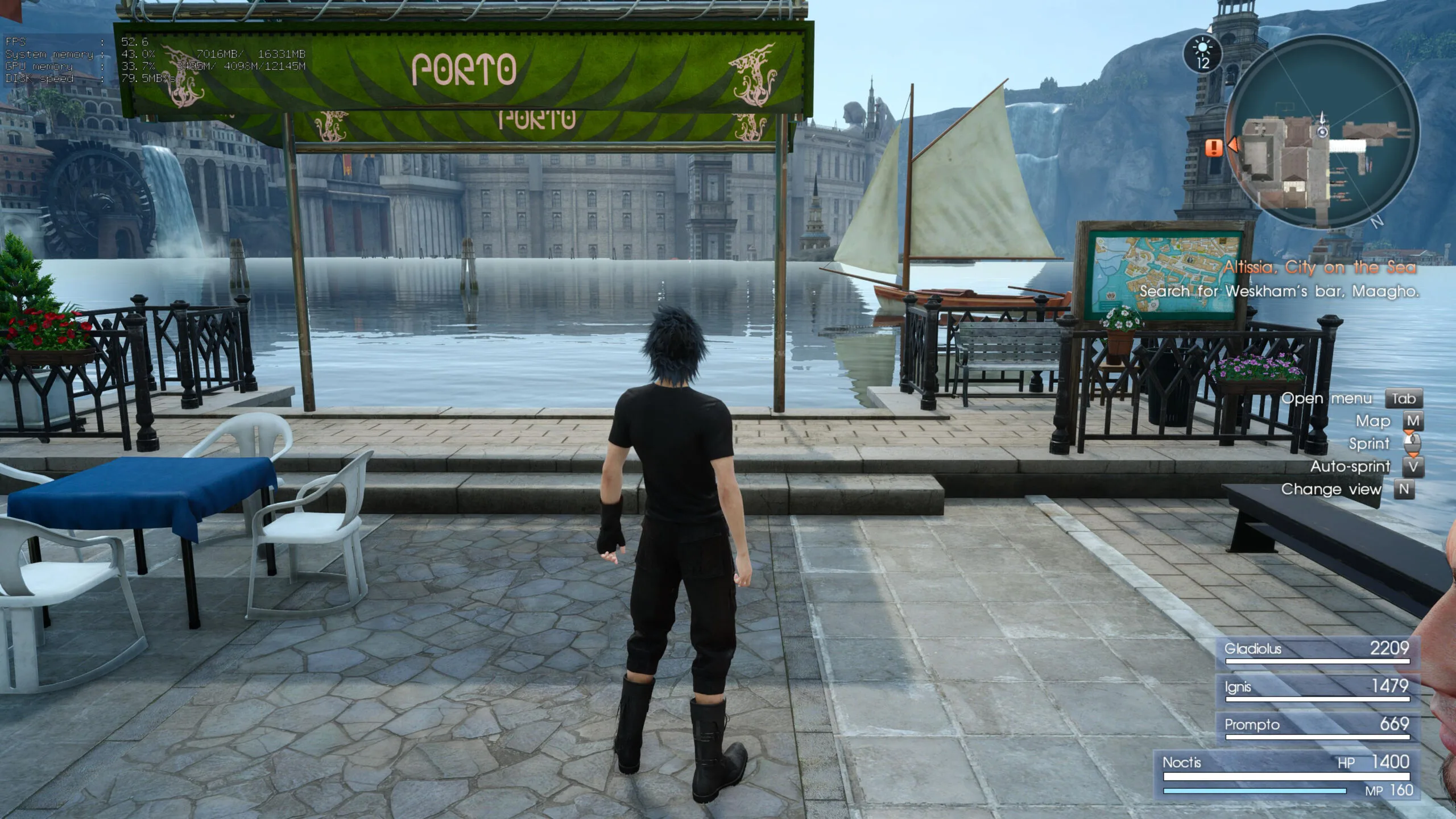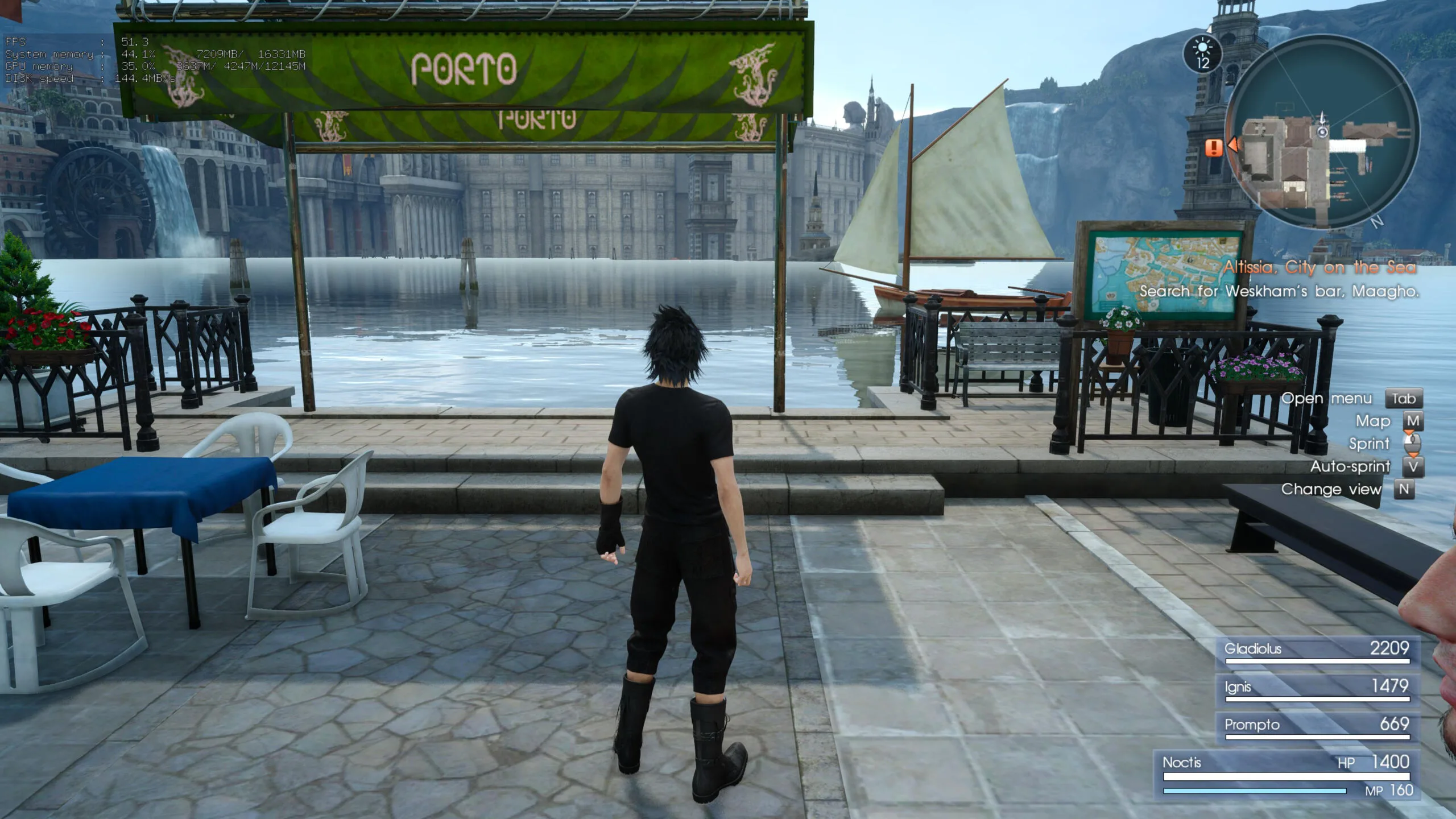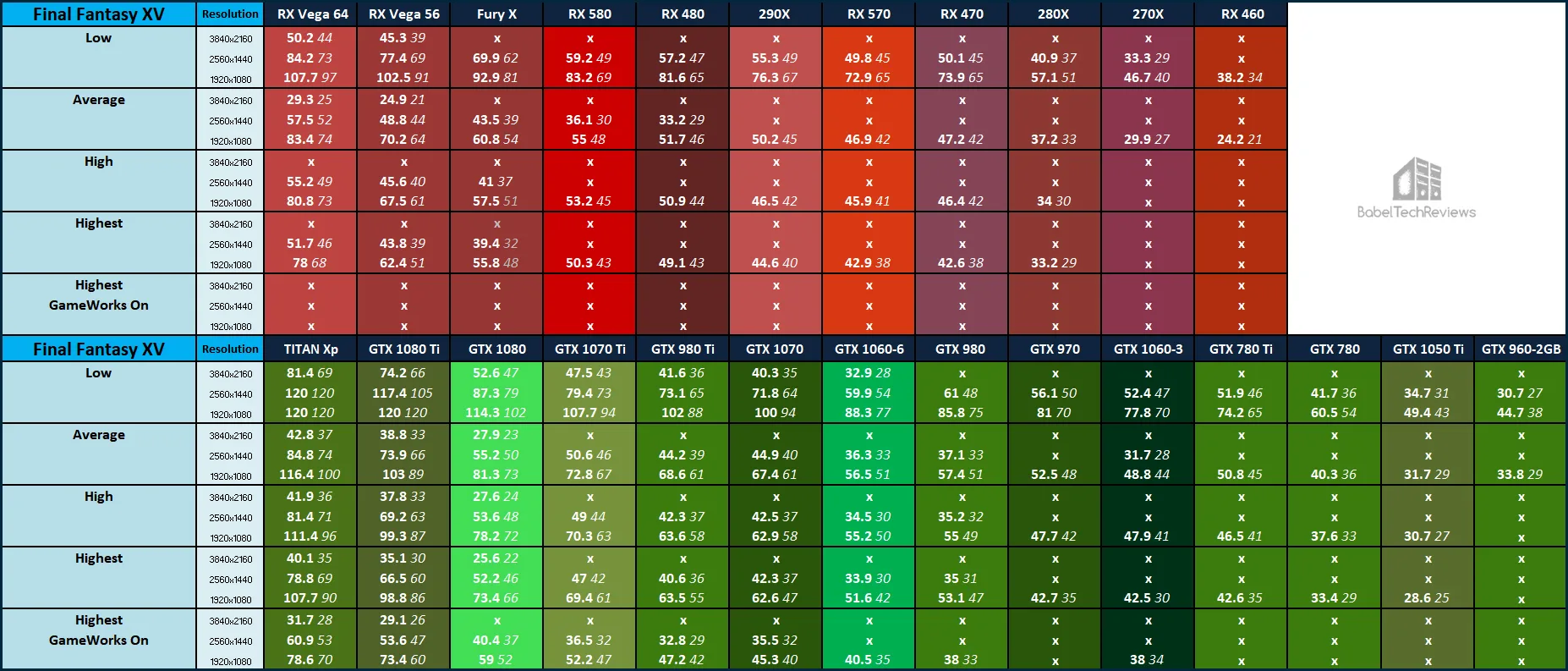AAA gaming has changed since the original Final Fantasy game released for the Nintendo Entertainment System. Iconic characters, amazing music, and fantastic stories give the series the esteem it has today, but since then the landscape has changed. Games like Skyrim and the Witcher 3 have created massive worlds with seemingly endless content and amazing worlds to get lost in. Square Enix’ development of Final Fantasy XV has been in in the works for over a decade and the studio has taken ideas from others to develop this title, and it truly delivers.
Square Enix has left the classic systems such as turn-based battles in the past with a modern battle system in an open world while retaining the classic JRPG style and role-playing elements fans want. This title is engaging with a great story that the series is known for with fun quests that still have that unique Final Fantasy feeling. Square Enix managed to deliver a game in one of the best packages the studio has ever put out. Sold now as Final Fantasy XV Windows Edition, this game includes all the DLC extras, updates, and NVIDIA-powered graphics enhancements that make this version of the game the definitive one.
Final Fantasy XV puts you in control of Noctis, the crown prince from the kingdom of Lucis who is forced to take on a greater role when his kingdom is invaded. Prince Noctis and his three constant companions must go on a long and winding journey across a massive world to save their kingdom. It is a familiar story the series is known for, but your companions and the living world around you are some of the most engaging and interesting experiences we have had in quite some time.
The game is unique as a large “buddy road trip” game that has all the side-quests, leveling, and character development hardcore fans are looking for. These characters are memorable and interesting, and as the story progresses we genuinely felt anger and shock as each chapter twists, turns, and evolves the narrative. Noctis, Gladiolus, Prompto and Ignis are very unique characters each with charming characteristics.
The constant banter and companionship they provide are some of the very best elements of the game. Final Fantasy XV then throws this group into a vast open world so large that you need a car just to get around it. There are hundreds of hours of content to enjoy along with fluid combat coupled with tight skill and gear development that make this game incredibly satisfying to play.
Final Fantasy XV is unique in the world of AAA gaming today while still retaining the development and progression fans of the series will enjoy. The gameplay and graphical fidelity are both fresh and beautiful to look at. However, before we discuss gameplay, let’s take a deeper look at Final Fantasy XV Windows Edition.
What’s included?
Any game with ten years of buildup and rumors will have trouble achieving perfection and will have a lot of hype to live up to. This game is far from perfect, but it is certainly a return to form for the studio and a welcome entry for old and new fans. Final Fantasy XV’s Americana, open-world, and JRPG gameplay is a vibrant, gorgeous, and a massive quest that anyone can jump into and enjoy. So what sets the Windows edition apart from the console release over a year ago?
Since Final Fantasy XV’s original console release in November, 2016, it has seen several DLCs released and the studio has even added cut scenes to clarify the story. The current version of the game also has some additional final boss battles and other minor tweaks that serve to further enhance the overall game and tighten up the original ending. It still suffers from becoming more linear near the end of the game but that doesn’t take away from the amazing journey it will take to get there. The road to the endgame can be long with hundreds of hours of great content including dozens of side-quests, hunts, fishing, and more.
Final Fantasy XV Windows Edition is a great package including all the post-launch DLC Square Enix has released for console. The base game on PC includes all current weapons, regalia skins, items and the three DLC episodes: Episode Gladiolus, Episode Prompto, and Episode Ignis. The game also includes the Final Fantasy XV: Comrades DLC that includes an online co-op mode that lets you explore the world and try quests with your friends.
Along with all the aforementioned content, PC gamers have been promised all upcoming story content and releases the studio puts out.
Mods, NVIDIA, and more
For the first time, first-person mode is available in Final Fantasy XV Windows Edition. This mode feels natural using the mouse and keyboard but some of the games menus and interactions still feel like they were designed for controllers. Overall, they are tight enough to feel great on PC and first person mode is there for gamers who may like it. This mode especially shines on high-end rigs and during the stunning battles that occur in the game. It’s what what makes PC gaming one of the best platforms to play on.
Mods
Final Fantasy XV Windows Edition has been out for about a week and we already have a mod that optimizes the game’s performance and brings even higher textures to it. We can only imagine the future mods that will enhance the title, like characters skins, new weapons, and more.
Speaking of textures, the game is massive and needs a total of 155 GB of storage space. This includes all the aforementioned DLC and base game along with 4K textures and HDR. The “normal” version of the game without the texture packs will still require around 100 GB of hard drive space. This game is huge and may be staggering for those with data caps or limited SSD storage space. We highly recommend installing this game on an SSD, as some of the loading times between chapters or large areas will remind you of playing Final Fantasy VII on console a little too much. Loading can take over a minute or even two at various sections of the game even on high-end systems using hard drives.
NVIDIA GameWorks features are quite welcome and they put the console versions of the game to shame. Final Fantasy XV Windows Edition is truly beautiful and the already great Luminous engine is enhanced by NVIDIA GameWorks technologies. The full potential of the game is realized only on the PC. Whether you are riding in your car, fighting a huge boss or a mob of enemies, or simply walking through a city, the world is stunning and absolutely gorgeous.
 If you have a graphics card at the GTX 1070 level and can turn all of these effects on, the benefits of these features become immediately evident in comparison to consoles and even over playing on a GTX 1050 Ti. The ability for PC gamers to use these technologies coupled with the game’s already impressive engine is a totally new experience for Final Fantasy gamers. Even if you don’t like Final Fantasy’s style, the game is simply stunning in 4K and hectic battles become easier to understand and process with faster frames per second seen only on high-end cards.
If you have a graphics card at the GTX 1070 level and can turn all of these effects on, the benefits of these features become immediately evident in comparison to consoles and even over playing on a GTX 1050 Ti. The ability for PC gamers to use these technologies coupled with the game’s already impressive engine is a totally new experience for Final Fantasy gamers. Even if you don’t like Final Fantasy’s style, the game is simply stunning in 4K and hectic battles become easier to understand and process with faster frames per second seen only on high-end cards.
Let’s take a look at the gameplay and new systems in Final Fantasy XV.
10 years Later, Final Fantasy has Evolved
Final Fantasy XV has gone through quite a wild journey to get to where we are today. The game has changed with the landscape and Square Enix has delivered fluid and fun combat with enough depth for hardcore fans. The game features a lock-on system that is extremely satisfying once mastered. The battle system features dodging, blocking and parrying attacks, linking with your partners for dynamic attacks, magic, and more. Royal Arms are also very strong specialized weapons that only Noctis can use, but although they drain his energy they can be great tools. Noctis can even summon a god at just the right moment when fighting a tough boss and it feels amazing the first time it happens.
These design changes and overall experiences in Final Fantasy XV feel like the perfect evolution that the series needed to undergo in the modern gaming world and is more easily accessible to newcomers because of these design choices. While we miss the old turn-based design of classic entries in the series, the revamped system is still fun and it feels fresh for a 2018 game. There is also a “wait” mode that serves as a middle ground for fans of slower paced combat. This mode allows you to pause between attacks and slows the gameplay down for those who like picking their targets and planning their attacks.
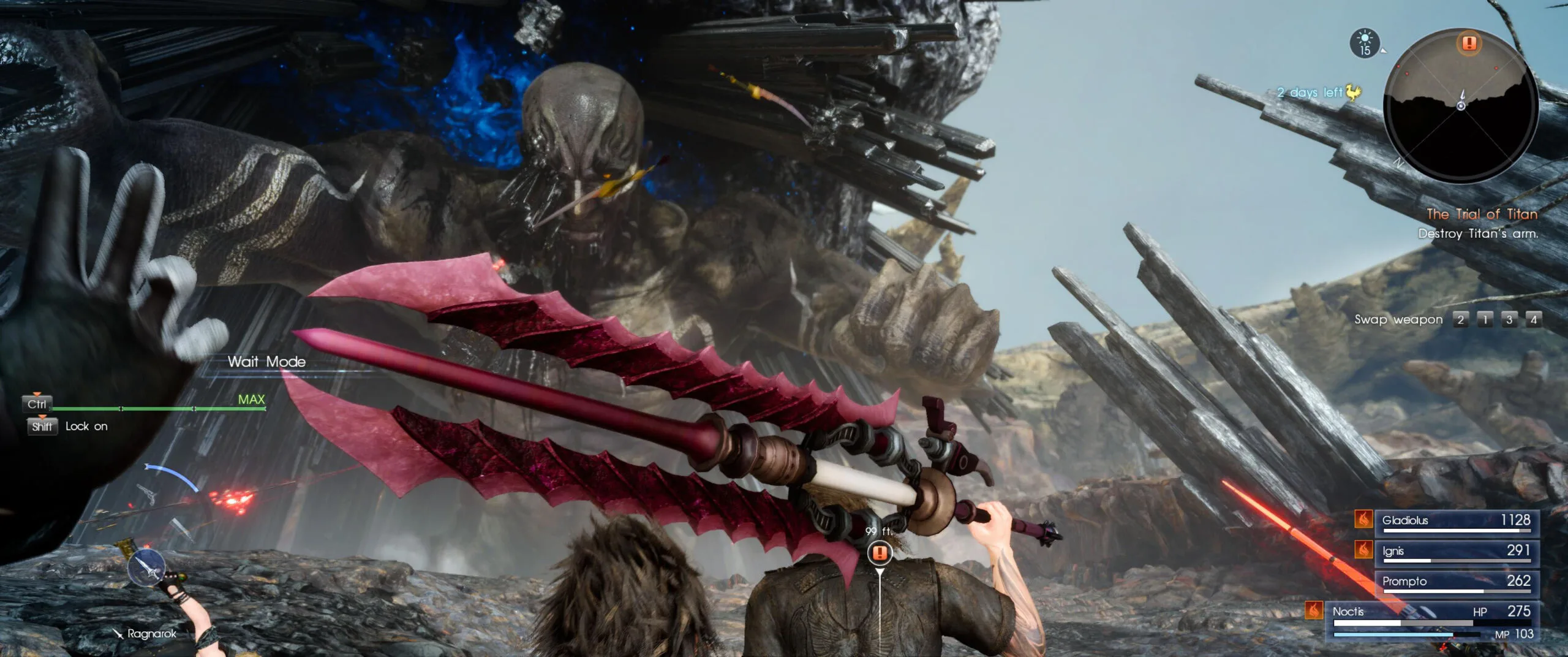
To be honest, the wait mode felt too slow when compared to the engaging and fun battles featured when using the normal system, although it is a very nice alternative for many people.
Noctis and his companions have several upgrade paths, weapons, and skills to keep combat interesting. The open world is full of quests and items to get and we enjoyed them, but gamers looking for dynamic events may be disappointed until much later in the game. Still, the game progresses quite nicely and grinding for EXP and levels are fun and interesting with your companions. Later chapters in the game open up the world and the experiences tie in together well. The banter between your companions also keeps it interesting along with various systems the game implements for progression. On rare occasions the conversations are deep.
For example, leveling-up requires sleeping in a hotel or making camp in the wild, and it felt natural with great transitions and with sometimes witty dialogue exchanges between the group. Riding Chocobos, Final Fantasy’s iconic chicken-like creatures, across vast fields is extremely different and great to experience on PC. It is hard to describe without experiencing it first-hand, but the camaraderie on the journey is truly engrossing and my fellow reviewer and I have jointly spent over 90 hours on the game and we have only barely scratched the surface of the game.
Some item gathering and repetitive side-quests may become boring as they lack diversity and are just small variations of the same concepts. Monster hunts, for example, are quests given to you by designated NPCs that let you gain some money and experience quickly by going out to specified areas and clearing a wave of enemies, a large boss, or random groups of demons. These events are fun and rewarding as they allow you to level up rather quickly but they are really a grinding tool that can be skipped. Still, we got sucked into weird side quests like fishing for a finicky cat who looked hungry.
The game is weird and design cues from Japanese developers thrown in like a random Cup Noodles stand in the city just make the game more memorable and uniquely Final Fantasy. Fun and interesting elements such as Prompto’s photos, Ignis coming up with new recipes, and more is the main strength of the game. You and your friends going on a journey in this huge weird world makes it one of the best role-playing experiences we have had for quite some time.
Square Enix has promised fans even more content for the game and we look forward to it. However, the game is demanding and some lower-end cards such as our GTX 1050 TI struggle to pass 34 FPS on average and our GTX 1060 6GB maxed out its performance capabilities at 1080p for the title.
Let’s take a deeper look at the gameplay, visuals and the performance of Final Fantasy XV
Performance and IQ
Final Fantasy XV is too big for just one reviewer to fully cover in just one week, so two of us tackled it. BabelTechReviews received a reviewer’s copy of Final Fantasy XV last week from NVIDIA, and a second key was purchased from retail. Both of us immediately began playing it, and we have put well over 90 combined hours total into the game.
Here are the 25 video cards that we tested at Highest, High, Average, and at Low settings at 1920×1080, 2560×1440, and at 3840×2160 resolutions with the very latest drivers. We also benched the fastest cards at Highest settings with all of the GameWorks features enabled.
In the middle of our benchmarking, AMD released their Adrenalin 18.3.2 drivers this week which gave us noticeable performance improvements especially for Fury X, Polaris, and also for Vega. Final Fantasy XV was also updated by a 106.7 MB patch while we were playing, but it did not affect our performance.
NVIDIA’s development team has helped Square Enix integrate their GameWorks library using Turf Effects, HairWorks, Voxel Ambient Occlusion, ShadowWorks and Flow technologies. One thing that immediately stands out is the incredible detail and impressive graphics at the game’s higher setting. The characters are nearly as detailed as in Crysis 3, and Final Fantasy XV succeeds in creating an immersive world. A lot of emphasis and time was placed on making the world feel alive and natural, and we really missed the GameWorks effects when we switched them off.

NVIDIA’s advanced GameWorks effects contribute to the realism of the game but they also take a significant performance hit. Fortunately, traversing the world with a high end video card can often be enjoyed with the GamesWorks effects on – the grass sways in the wind, the NPCs’ hair and fur moves naturally, and shadows look more real. Best of all, GameWorks can switched off by simply escaping to the menu and toggling it off if more performance is needed for fighting.
Below are the major settings which include Low, Average, High, and Highest (shown below). Each time a player toggles between these major settings, unlike toggling GameWorks effects on or off, the game needs to restart, and any progress since the last save may be lost. However, it makes no sense to enable GameWorks unless you are on the High or Highest settings and have enough performance headroom to use them without slowing framerates down too much.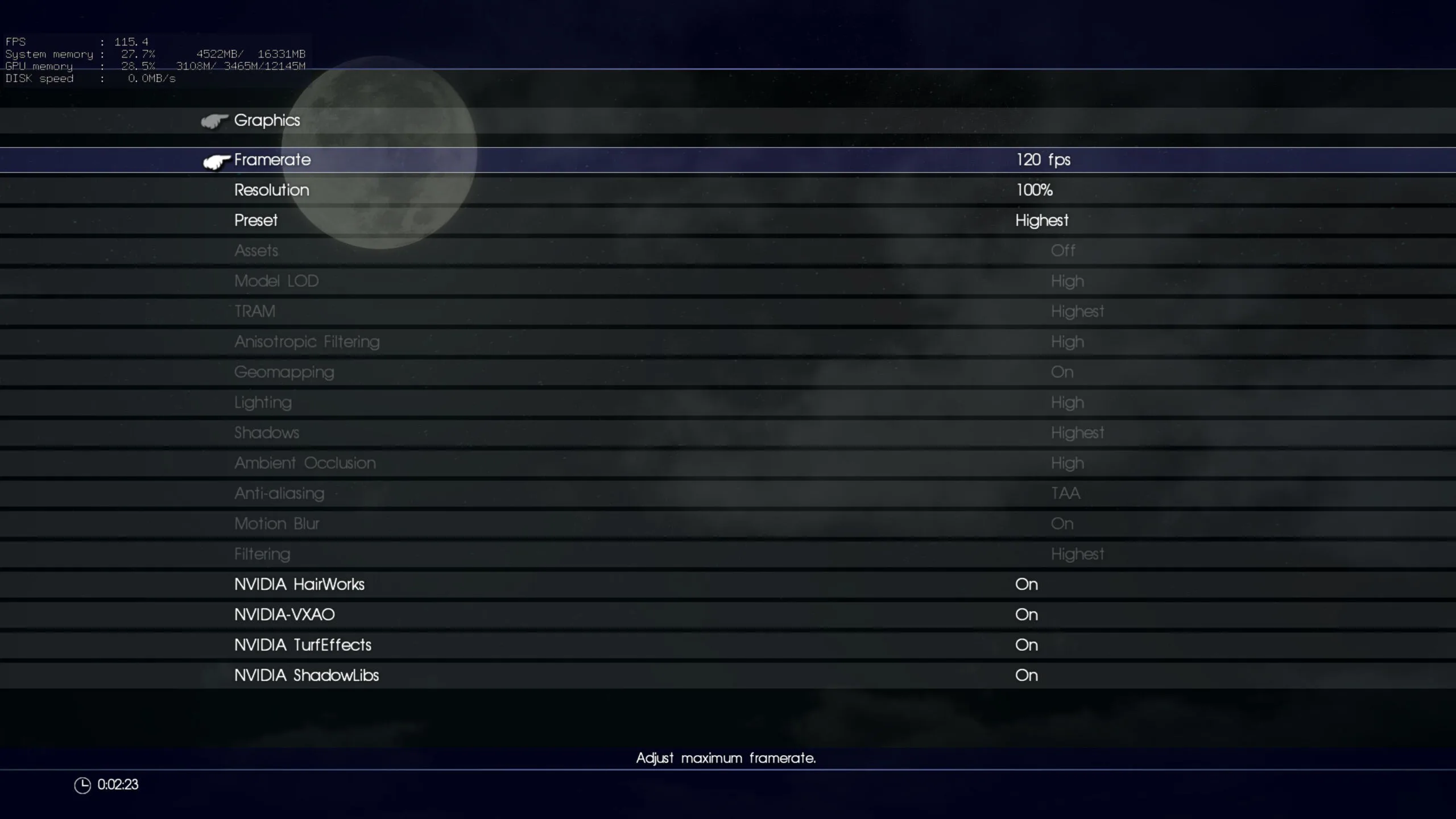

We are going to compare the performance of 25 video cards by changing the four major settings, and we will also look at the image quality (IQ) differences that result from changing these settings.
Bugs, Graphics and Performance
Final Fantasy XV is a massive open world game with its Highest visuals that put it in the top ten. But loading times even from a SATA SSD are relatively slow. It takes about 30 seconds to launch the game, and then it takes approximately 30 seconds for the first game load, and then about 20 seconds for each subsequent level load. Still, it’s a lot better than the up-to-two minutes that it can take to load the game from a HDD.

We encountered few bugs, and during more than 50 hours of play, this editor experienced only a few lock-ups which required a game restart. Although there has been only one patch since we started playing the game, it is a very polished experience. There is a very strange bug that halted progress beyond a certain point with the TITAN Xp that would crash the game to desktop. After switching to a GTX 1080 Ti, we were able to pass that point, and we even returned to playing with our TITAN Xp as it offered us the best experience.
We found that playing at 4K with the highest settings and with GameWorks on is too demanding for any current video card. An overclocked TITAN Xp will maintain framerates above 30 FPS which is what the devs targeted, but it is not a satisfactory experience even with GSYNC enabled especially during the more demanding fight scenes where fluidity is needed most.

For us, playing on a 3440×1440 GSYNC-enabled display with a TITAN Xp, framerates could dip into the upper-30s while remaining reasonably fluid, or into the upper-40s FPS without GSYNC. However, for us, minimum framerates should ideally remain at least in the 50s FPS for fluid gameplay during battles. This meant that most of the time GameWorks features were off. It’s unfortunate that multi-GPU is not supported, but the GameWorks features are quite forward-looking, and we are already eager to play this game at 4K/60 FPS with everything enabled on the next generation of video cards.
Final Fantasy XV is very scalable and Very High can be played on high-end GPUs at 3440×1440 while lower end cards like either a GTX 1050 Ti or a Radeon 270/370X can still be played on Low at 1920×1080. Video memory appears to be very well-managed usually staying just below whatever the amount of vRAM a card has; either a TITAN Xp or a GTX 960 2 GB card will each have their memory nearly fully utilized. Even the Fury X 4GB can achieve decent framerates at High/1920×1080.
Ansel

Unfortunately, Ansel integration has to be submitted to the bug list. If you have the GeForce Experience installed, with the ALT+F2 command Ansel will capture images, but the color balance is off and many outdoor scenes look washed out. Ansel is an incredible screen capture tool that can capture in Super Resolution and even in 360 degrees as well as providing advanced filters and editing tools. We look forward to using Ansel again after its issues are addressed by a future driver update.

Performance
We played Final Fantasy XV at Very High details through more than 35 hours at 3440×1440 to find the perfect benchmark in Chapter 9. It is far more demanding than most of the other potential repeatable benchmarks that we found in earlier chapters, and it is close to “worst case”. This benchmark is about as demanding as the most intense boss fights as there are a lot of changing reflections, shadows, high textures, effects, and long draw distances.
Here is BTR’s Final Fantasy XV benchmark as captured by Shadowplay at 4K but uploaded to Youtube at 1920×1080 with all the GameWorks features enabled on the Highest settings. Notice that the overclocked TITAN Xp manages to stay at 30 FPS or above.
There is some visible artifacting around the body of the gondola operator that we will hope be addressed soon. We played Final Fantasy XV mostly using our Pascal TITAN Xp and GTX 1080 Ti at 3440×1440 on an ACER Predator 34″ GSYNC display, and then replayed much of it with our 23 other video cards using our Core i7-8700K at 4.7 GHz, an EVGA Z370 FTW motherboard and 16GB of Kingston HyperX DDR4 at 3333MHz.
On the next page, we will introduce static image quality screenshots to compare the main settings, and later we will give the performance results. Let’s check out the settings that we used as well as their impact on Image Quality (IQ).
The Final Fantasy XV developers targeted 30 FPS which may be OK for consoles, but it is not so good for playing fluidly on a PC. Low is really low compared to the other 3 settings which are grouped far closer together in performance, but Low allows RX 270 and GTX 1050 Ti gamers to play at 1920×1080, although some players may further lower the resolution if necessary.
Image Quality & Settings
The main settings are Low, Average, High, Highest, and any of these settings may be played with GameWorks enabled or disabled. It makes the most sense to us to enable GameWorks only if there is enough performance at High or Highest detail settings. A NVIDIA graphics card owner may also choose to use the GeForce Experience to suggest optimal settings. Custom settings can be chosen for more control over the individual settings under each main grouping.
Now let’s look at a series of screen shots takes from the same place beginning with Low and progressing through Average, High, Highest, and Highest plus all of the GameWorks features on.
Low
Our first impression after dropping from Highest to Low, was … Half Life 2. There is a big difference visually, and it is a shock going from the highest to the lowest settings. However, Low settings look decent even if the lighting is a little washed out, but the detail is still acceptable. Lighting is harsh, shadows are not softened, and we don’t see any anti-aliasing. Draw distances are down and there are no reflections on the water.
Low is perfect for the low end cards which now include the GTX 960-2GB and the Radeons 270X/370X but also the newer cards like the RX 460/560 and the GTX 1050/Ti. The next step up, Average, gives the largest improvement visually, but it also takes the biggest performance hit percentage-wise.
Average
Average settings look much better than on Low and there is now more detail and there are basic reflections.
Average is a good choice for midrange graphics cards as the lighting improves, there is some measure of anti-aliasing applied, and the detail sharpens. Final Fantasy XV on Average looks pretty decent and the immersion improves significantly over Low settings. The next step, High, improves incrementally over Average
High
High improves further on the lighting, draw distance and details. However, if you have a choice between having to turn settings down to Average or suffering with low framerates on High, we would suggest that while playing the game, you may not really notice the visual difference.
High is a good balance of visuals for upper midrange cards.
Highest
Highest is the top setting and if your PC can handle it, it is a great experience. The draw distance increases to maximum, higher textures are used, the shadows soften, and lighting is improved.
Highest settings are very demanding and should only be used by perhaps the TITAN Xp or a GTX 1080 Ti above 2560×1440, and a GSYNC enabled display is always recommended. Highest settings are also playable on upper-midrange video cards at 1920×1080. But there is one further group of settings that are perhaps saved for future graphics cards as GameWorks adds further realism to the game but really slows down performance.
Highest plus GameWorks
GameWorks settings, especially HairWorks, really affect performance and they are best left off except for taking screen shots unless you have a TITAN Xp or a GTX 1080 Ti and a very powerful PC. Fortunately, G-SYNC smooths the experience so that framerate drops into the 40s can be tolerated at 3440×1440 or 2560×1440. If a non-synchronized display is used, 50 FPS should be the minimum target for fluid gameplay.
With GameWorks settings on, the entire game becomes more “real”. Interactive, tall grass waves naturally in the wind, the NPC’s hair and fur move naturally, lighting is improved, and fluid physics make fire and smoke behave properly. However we did not post GameWorks enabled settings results on AMD cards because they take a significantly higher performance hit than do NVIDIA cards which are optimized for GameWorks. It’s a hard choice to make between playing at a higher resolution or enabling GameWorks.
Final Fantasy – IQ in motion
Low is a mess of aliased and shimmering textures that crawl with the camera in motion. Average settings help, and as one moves up through the settings, the game looks great and aliasing in motion is greatly reduced. There are some issues with texture pop-in that are made a bit worse by the texture pack, but overall, it adds a bit to the visuals.
Final Fantasy XV looks fair and runs good at at Low settings, but by the time we get to the Highest settings, we begin to sense what Square Enix’ Luminous Engine is capable of once future hardware gets faster. We also got to play the game in HDR, but our 4K display doesn’t have sufficient brightness to really differentiate the game’s lighting.
Let’s look at our Test configuration on the next page.
Test Configuration – Hardware
- Intel Core i7-8700K (HyperThreading and Turbo boost is on to 4.7 GHz; DX11 CPU graphics).
- EVGA Z370 FTW motherboard (Intel Z370 chipset, latest BIOS, PCIe 3.0/3.1 specification, CrossFire/SLI 8x+8x), supplied by EVGA
- HyperX 16 GB DDR4 (2×8 GB, dual channel at 3333MHz), supplied by HyperX
- TITAN Xp 12GB, Star Wars Collectors Edition, supplied by NVIDIA
- GTX 1080 Ti 11 GB, Founders Edition, supplied by NVIDIA
- GTX 1080, 8 GB, Founders Edition, supplied by NVIDIA
- GTX 1070 Ti 8 GB, Founders Edition, supplied by NVIDIA
- GTX 1070 8 GB, Founders Edition, supplied by NVIDIA
- GTX 1060 6GB, Founders Edition, supplied by NVIDIA
- EVGA GTX 1060 3GB, supplied by EVGA
- PNY GTX 1050 Ti XLR8, 4 GB, supplied by PNY
- GTX 980 Ti 4GB, Founders Edition, supplied by NVIDIA
- GTX 980 4 GB, Founders Edition, supplied by NVIDIA
- GALAX GTX 970 EXOC 4GB, supplied by GALAX
- ASUS Strix GTX 960 2 GB, supplied by ASUS
- GTX 780 Ti 3 GB, Founders Edition, supplied by NVIDIA
- GTX 780 3 GB, Founders Edition, supplied by NVIDIA
- Gigabyte RX Vega 64, Liquid cooled edition, 8 GB
- Red Devil RX Vega 56, 8 GB, supplied by PowerColor
- Fury X 4GB
- Red Devil RX 570, 8 GB, supplied by PowerColor
- Gigabyte RX 480 8GB at 1290 MHz factory clocked and at RX 580 speeds (1340 MHz)
- Red Devil RX 470 4GB, supplied by PowerColor
- PowerColor 290 X PCS+ (reference design) 4 GB
- VisionTek 270X, 3 GB, supplied by VisionTek
- PowerColor 270X PCS+, 3 GB, supplied by PowerColor
- Two 480 GB Team Group SSDs, one for each platform
- 1.92 TB SanDisk SSD for additional game storage
- EVGA 1000G 1000W power supply unit
- EVGA CLC 280mm CPU cooler, supplied by EVGA
- Onboard Realtek Audio
- Genius SP-D150 speakers, supplied by Genius
- EVGA DG-77 mid-tower case, supplied by EVGA
- ASUS 6X Blu-ray USB writer
- 28″ Monoprice Crystal Pro 4K
- ACER Predator 34″ G-SYNC WHQD display, supplied by ACER/NVIDIA
- 43″ LG HDR enabled 4K TV
Test Configuration – Software
- GeForce WHQL 391.01 was used for all NVIDIA cards. High Quality, prefer maximum performance, single display. See control panel images below.
- AMD Software 18.3.2 drivers were used for all AMD cards. 18.3.1 was used to compare the performance increase using the RX 480/580. See control panel image below.
- VSync is off in the control panel. G-SYNC is off.
- Specific settings enabled as noted on the chart.
- All results show average frame rates including minimum frame rates shown in italics on the chart next to the averages in smaller font.
- Highest quality sound (stereo) used in all games.
- Windows 10 64-bit Home edition
- Final Fantasy XV Windows Edition key was purchased from Green Man Gaming and another came courtesy of NVIDIA. The game has been patched to its latest version at time of posting.
- Sapphire TriXX overclocking utility used to set the AMD cards Power Draw to +50% and to reference speeds – except for RX Vega which are both set to Balanced for stability.
- MSI’s Afterburner used to set all NVIDIA Power Limit and temperatures to maximum and clocks to reference speeds.
AMD Adrenalin Control Center Settings:
All AMD settings are apples-to-apples compared with NVIDIA’s control panel – all optimizations are off, Vsync is forced off, Texture filtering is set to High, and Tessellation uses application settings for all cards tested.
NVIDIA Control Panel settings:

Let’s check the performance of our 25 video cards on the next page and then head for our conclusion.
Performance & Conclusion
NVIDIA has their own optimization suggestions which may be quite helpful, or a player can just use the GeForce Experience included with the latest recommended 391.01 GeForce drivers. The GeForce Experience will, at the touch of a button, set near-ideal custom settings for any PC and for more than 100 games including for Final Fantasy XV.
For the best AMD experience, use the latest drivers – Adrenalin 18.3.2 driver – which is optimized for Final Fantasy XV. Here are the performance changes from 18.3.1 to 18.3.2 using a Gigabyte RX 480 at 1290 MHz (stock clocks are 1266 MHz) and the same card simulating a stock RX 580 at 1340 MHz.
AMD’s performance improvement of “up to 7%” for RX 580 at 1920×1080 appear to be accurate, and these new drivers have made Fury X playable.
Performance
There is a no built-in benchmark but our run is reasonably representative of the most demanding gameplay. Here are our performance results using 25 video cards at 3 resolutions using Highest+GameWorks, then Highest, High, Average, and Low settings. The main summary chart serves as a spreadsheet that displays all of the information so that it may be easily cross-referenced. Unfortunately, the AMD and NVIDIA cards cannot be ranked together, as the graph would become much too long.
AMD cards are grouped together as are NVIDIA cards from their flagship cards, down to the low end and are tested at resolutions that make sense with Average FPS in bold text followed by Minimums in smaller font italics.
Any of our lower-end cards can play reasonably well at Low settings at 1920×1080 except for a RX 460/560. However, once the settings are increased to Average, a player will need a RX 470/570 or a GTX 1050 Ti to play at 1920×1080. Moving from Low to Average is the largest improvement jump visually, but it also takes the biggest performance hit percentage-wise. Moving from Average to High and from High to Highest require incremental performance power increases from a video card, but each step up in the settings also provides incremental visual improvement.
Enabling GameWorks features adds realism but it takes a solid performance hit. HairWorks probably takes the largest performance hit compared with the other three GameWorks settings, and a player may wish to experiment by enabling the settings individually. GameWorks features are worth turning on to check out on a NVIDIA card, but it makes a proportionally larger negative performance impact on Radeons.
Final Fantasy XV is a very scalable game that can run fluidly on a wide range of video cards depending on the settings chosen, but it looks incredible at Highest settings and we wish that we could enable all of its features. Let’s head to our Conclusion.
Conclusion
Ultimately, Final Fantasy XV is a game that you can sink hundreds of hours into if you truly want to, but it can also become tedious with repetitive and tiresome side quests and hunts. There’s many elements to this game that are interesting and a great course-correction for the franchise that has had its ups and downs over the years. Final Fantasy XV is a great package that was a long time coming for PC fans and it is well worth taking a look at the game.
There are well over 200 hours here with all the DLC included in the package and a gamer will get his money’s worth. Square Enix did a good job of porting the game to PC, and this unique and fun game is one we will definitely return to and take our time with to complete. Some of the changes may be hard for hardcore fans of the classic series to like, but there is just too much good fun to be had with Noctis and his friends to simply ignore the title.
Final Fantasy XV has become BTR’s latest benchmark. Stay tuned as we have many more reviews and evaluations coming up. But we cannot wait to get back to playing the game and completing at least the main quest. It is that good.
Next up, we’ll review Far Cry 5 and also ARK: Park VR before heading to NVIDIA’s GTC. Afterward, you can expect a full review of Team Group’s 2×8 GB 3000 MHz DDR4 kit and, then we will bring you another mega 20-game VR showdown between AMD’s and NVIDIA’s best video cards.
Happy Gaming!

